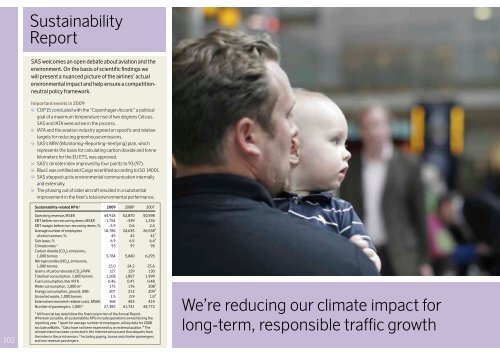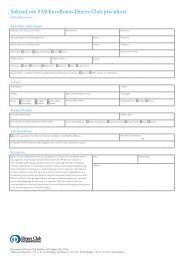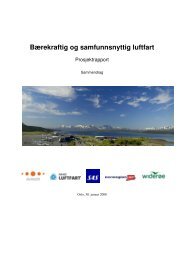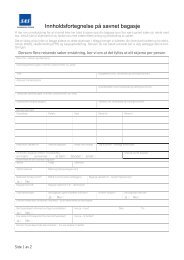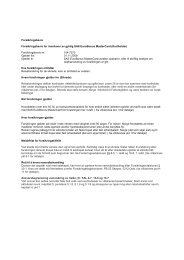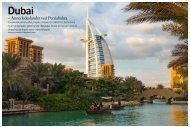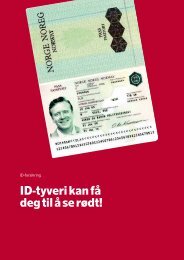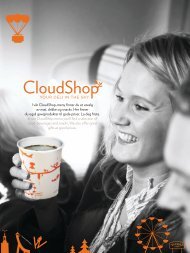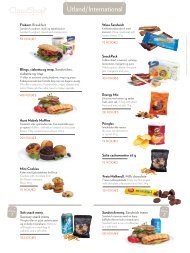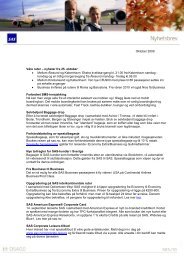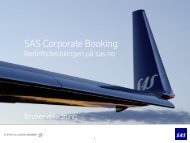Sustainability Report We're reducing our climate impact for ... - SAS
Sustainability Report We're reducing our climate impact for ... - SAS
Sustainability Report We're reducing our climate impact for ... - SAS
You also want an ePaper? Increase the reach of your titles
YUMPU automatically turns print PDFs into web optimized ePapers that Google loves.
how air traffic management will be optimized is SESAR JU (theSingle European Sky ATM Research Joint Undertaking), with thegoal <strong>for</strong> 2020 of <strong>reducing</strong> travel times by 8-14 minutes, cuttingfuel consumption by 300-500 kg and thus <strong>reducing</strong> CO 2emissionsby 1-1.5 tonnes <strong>for</strong> an average European flight.Impact of air transportThe airline industry currently accounts <strong>for</strong> 2-3% of global CO 2emissions, which is equal to around 12% of the transportationsector’s global emissions. CO 2emissions account <strong>for</strong> about twothirdsof air transport’s total <strong>impact</strong> on <strong>climate</strong>, while NOx, watervapor and particulates are assumed to be responsible <strong>for</strong> most ofthe balance.Under the Kyoto Protocol commitments, which extend to2012, all industrialized countries must reduce their emissions by5%, compared with 1990-levels. The EU has gone a bit further,pledging to reduce the community’s total CO 2emissions outsidethe Emissions Trading Scheme (ETS) by a total of 20% by 2020.The airlines will be included in EU emissions trading in 2012.Industry and IPCC estimates indicate a possible reduction inCO 2emissions of 2% per year on average through new technologyand efficiency gains. This trend, in combination with expectedAir transport’s share of global carbon emissionsAir transport 2%Other transport 12%Agriculture 14%Energy/other 72%S<strong>our</strong>ce: EEA/IPCC (2004)Air transport’s share of the transportation sector’s totalcarbon emissionsAir transport 12%Shipping/rail 12%long-term growth, means that aviation’s environmental <strong>impact</strong>will increase if no actions are taken. That is why the entire aviationindustry agreed on ambitious, long-term environmental goals.Read more on p. 103.For long j<strong>our</strong>neys there is no real alternative to flying. Historically,air transport has belonged to the industrialized world.Today, the major growth in both nominal and relative terms istaking place in Asia and the Middle East, while Africa continuesto post modest growth. In countries within these geographicalareas both private persons and industry can now utilize the infrastructurepreviously reserved <strong>for</strong> the industrialized world. Thus,environment-motivated global restrictions on aviation wouldprimarily affect those who previously neither had the means northe opportunity to fly. Air transport is there<strong>for</strong>e a key part of theinfrastructure of a globalized world, necessary <strong>for</strong> economic andsocial progress.<strong>SAS</strong>’s main market is the Nordic region, with emphasis ontravel to, from and between the Nordic countries. The Group’sshare of total traffic in its main markets is around 37%. All ofNorwegian domestic traffic accounts <strong>for</strong> 1.7% of national CO 2emissions. The corresponding figures <strong>for</strong> Danish, Swedish andFinnish domestic traffic are 0.4%, just under 1% and 1.3%, respectively.(S<strong>our</strong>ce: National statistics).Emissions tradingIn 2008 the EU adopted the revised general ETS directive anda special directive to include air transport into the EU/ETS from2012. The aviation directive may be overhauled in 2014 to enablea global ETS system.The decision means that the airlines must deliver one emissionallowance <strong>for</strong> each tonne of CO 2emitted. Airlines will beallocated approximately 80% of the allowances at no cost, with2004-2006 as a base period. The remainder, including anyemission increase, must be purchased in the market. <strong>SAS</strong> estimatesthat the costs may amount to MSEK 200-300 per yearbased on expected production and an estimated credit price ofEUR 30 per tonne.So far, the <strong>climate</strong> <strong>impact</strong> of air transport has concentrated onCO 2emissions. Now that emissions trading is being introduced,the focus is likely to be on other environmental <strong>impact</strong>s, primarilyNOx and contrails.Industry and scientists generally agree on the magnitudeand effects of CO 2emissions. There is less agreement, however,regarding NOx, particulates and water vapor. At the same time,there are increasing calls <strong>for</strong> introducing some <strong>for</strong>m of tax onNOx. <strong>SAS</strong> and the airline industry recommend the ECAC modelwith differential landing fees based on NOx emissions. Thereare also suggestions to use a multiplier, though its size is controversialand not based on scientific findings. Ten years ago, amultiplier of 2-4 was under discussion, while the current value isaround 1.2-1.8. The issue is on the EU agenda, and some <strong>for</strong>m ofdecision is expected no later than 2012. See the article fromCicero on aviation’s environmental <strong>impact</strong> at www.sasgroup.netunder “<strong>Sustainability</strong>.”<strong>SAS</strong> fully endorses the “polluter pays principle” and isprepared to account <strong>for</strong> its share. This assumes that any taxesimposed on it are based on scientific findings and that the total<strong>climate</strong> <strong>impact</strong> of competing modes of transportation is takeninto consideration. In the current debate, the actual environmental<strong>impact</strong> of air transport is, in many respects, often unfairlyand crudely depicted. It is also important that EU environmentalstandards not create conditions that disadvantage Europeanover non-European airlines.An AEA working group, with <strong>SAS</strong> participation, has put <strong>for</strong>tha proposal <strong>for</strong> a global system called GAP (Global Approach <strong>for</strong>International Aviation Emissions), which takes into account theUN CBDR principle (Common But Differentiated Responsibility),aimed at leveling the playing field <strong>for</strong> airlines. The proposaldivides the world into three blocs, with more onerous obligationson the industrialized zone than on developing countries. Moreover,IATA is working on a document outlining ideas <strong>for</strong> economicinstruments <strong>for</strong> <strong>reducing</strong> air transport’s CO 2emissions.Environmental policiesAirline operations are subject to the environmental policiesapplic able to each airport. These usually involve noise, rules <strong>for</strong>using deicing fluids and limits on emissions to air and dischargesinto soil and water.104Road transport 76%S<strong>our</strong>ce: Stern <strong>Report</strong> 2000, WBSCD (2004)<strong>SAS</strong> Group <strong>Sustainability</strong> <strong>Report</strong> 2009
What comes in and goes outIn 2009, <strong>SAS</strong> did an updated survey of the Group’s busiestScandinavian airports and engaged in dialogs with them to ensurethat they had the required permits.One of Stockholm-Arlanda Airport’s environmental rules is aceiling <strong>for</strong> how much CO 2and NOx the airport may emit. In 2008the Environmental C<strong>our</strong>t ordered a postponement from 2011 to2016 of the date when Arlanda’s emission ceiling is supposed togo into effect, provided that LFV submits an application <strong>for</strong> a newenvironmental permit by no later than the end of 2010. However,on <strong>for</strong>mal grounds, the Supreme C<strong>our</strong>t rejected this linkage betweena change in terms and the application, which means thatthe emission ceiling will be compulsory in 2011. LFV has beenworking on an application <strong>for</strong> a whole new environmental permitsince 2008, and the goal is to submit it at year-end. When thisapplication is considered, the emission ceiling will be examinedin its entirety, which <strong>for</strong> <strong>for</strong>mal reasons was not possible in theSupreme C<strong>our</strong>t hearing. <strong>SAS</strong> has extensive activities at Arlandaand is very much dependent on the airport’s environmentalpermit.The environmental permit <strong>for</strong> Copenhagen Airport includes anoise limit of 80dB(A) <strong>for</strong> night traffic. <strong>SAS</strong> is evaluating technicalfixes <strong>for</strong> lowering the noise level of its MD-80 aircraft. So far, thisattempt has not had satisfactory results. At the same time, <strong>SAS</strong> is<strong>reducing</strong> its need to use MD-80 aircraft, and airport noise limits arenot expected to have any material effect on <strong>SAS</strong>’s traffic planning.Due to stricter noise standards, a growing number of airportshave tougher restrictions regarding permitted approach andtakeoff corridors. Deviations generally result in fines on the airline.LFV has appealed a judgment regarding noise restrictionsin connection with Landvetter Airport outside Gothenburg.<strong>SAS</strong> and LFV believe that since the judgment does not take intoaccount all factors <strong>impact</strong>ing the environment, it unfairly affectsairlines with good environmental per<strong>for</strong>mance.In general, the trend is toward increased use of environmentrelatedcharge systems and operational limits. The twofoldpurpose is to reduce local environmental <strong>impact</strong>s and createincentives <strong>for</strong> airlines to speed up the use of aircraft with the bestavailable “green” technology. Read more about policies andviolations in the <strong>Report</strong> by the Board of Directors, pp. 52-53.INININ<strong>SAS</strong>’s responsibilityAviation fuelEngine oilHalonsFood and beveragesPackagingDisposable/semidisposableitemsArticles <strong>for</strong> saleNewspapersChlorinated waterGermicides* Direct and indirect responsibilityAir<strong>SAS</strong>’s responsibility* Cabin<strong>SAS</strong>’s responsibility* Airport owner’sresponsibility<strong>SAS</strong>’s responsibility* Ground services <strong>SAS</strong>’s responsibility* Airport owner’sresponsibilityGlycolsWaterMaintenance suppliesEnergyVehicle fuelOffice suppliesChemicalsEquipmentWork clothes and uni<strong>for</strong>msAirport owner’s responsib.Urea/Acetate<strong>SAS</strong>’s responsibilityCarbon dioxide (CO 2)Nitrogen oxides (NOx)Hydrocarbons (HC)Volatile organic compounds (VOC)Oil aerosolsJettisoned fuelNoiseWater vapor (H 2O)Sulfur dioxide (SO 2)Carbon monoxide (CO)Halons (CFC)Flight operations account<strong>for</strong> an estimated 95%of <strong>SAS</strong>’s environmental<strong>impact</strong>Organic wasteWasteUnopened packagingWaste and recyclingLavatory wasteCabin operations account<strong>for</strong> an estimated2% of <strong>SAS</strong>’senvironmental <strong>impact</strong>Wastewater(disposal)Lavatory waste(disposal)WasteHazardous wasteGlycolsWastewaterSulfur dioxide (SO 2)Carbon dioxide (CO 2)Nitrogen oxides (NOx)Hydrocarbons (HC)Soot and particulatesVolatile organic compounds (VOC)Ground operationsaccount <strong>for</strong> anestimated 3% of <strong>SAS</strong>’senvironmental <strong>impact</strong>Urea/AcetateWastewater(disposal)OUTOUTOUTFlygMoHalSee also Environmental management system on p. 111.<strong>SAS</strong> Group <strong>Sustainability</strong> <strong>Report</strong> 2009 105
106Environmental vision<strong>SAS</strong> intends to be a leader in work toward sustainabledevelopment in air transport, thus contributing to sustainablesocial progress.<strong>SAS</strong> intends to have the most ambitious long-term environmentalprogram in the airline industry.Principal strategic targetsIn line with IATA’s vision, the overriding long-term objective of<strong>SAS</strong>’s environmental work is to make it possible to fly withoutgreenhouse emissions by around 2050.20% lower emissions by 2020, traffic growth included50% lower emissions per unit produced by 2020Environmental goals 2008–2011<strong>SAS</strong> will be seen as the most environment-conscious airline in Europe have ISO 14001-certified environmental management systems have the industry’s most effective fuel saving program be among the first airlines to use alternative fuel blendsonce they are approved and commercially availablehave a long-term plan <strong>for</strong> its aircraft fleet that leads to asignificant reduction of greenhouse emissionshave reached the target <strong>for</strong> <strong>SAS</strong>’s eco-efficiency index.The <strong>SAS</strong> Group’s vision, goals and strategies <strong>for</strong> itssustainability work are reported in their entirety atwww.sasgroup.net under “<strong>Sustainability</strong>.”<strong>SAS</strong>’ environmental strategy targets <strong>for</strong> 2020 1Million tonnes C0 2Based on 4% annual growth9.08.07.06.05.04.03.02006 2010 2014 2018 2020Actual outcome 2Expected trend if no actions takenExpected trend with planned replacement of aircraft fleet20%reductionby 2020Expected trend with planned replacement of aircraft fleet and other measures1 Adjusted from 2005 to reflect the current Group. 2 Improvement explained bya 15-20% decline in traffic and higher energy efficiency.Goals, strategies and goal attainmentThe overall objective of <strong>SAS</strong>’s sustainability work is to createlong-term growth in shareholder value and help the Group reachits goals. Formulated goals and adopted strategies <strong>for</strong> sustainabilitywork are a part of Core <strong>SAS</strong>. The environmental goals <strong>for</strong>2011 are to lay the groundwork <strong>for</strong> <strong>SAS</strong>’s operations becomingsustainable in the long term.In 2009 <strong>SAS</strong>’s sustainability work continued at high intensity in allGroup units in line with the action plans drawn up in 2008 <strong>for</strong> reachingthe goals by no later than 2011. The deterioration in the marketenvironment has not affected goals or timetables.This section reports the current status at the end of 2009 andmeasures planned <strong>for</strong> 2010.<strong>SAS</strong> will be seen as the most environment-consciousairline in EuropeGoal attainment 2009The goal to step up external communication and involvementwas pursued by publishing an environmental folder, articles ininternal and external publications and by heavy involvement inenvironmental conferences, seminars and presentations. Environmentalwork was enhanced in all areas to ensure that theenvironmental strategy goal is reached in 2020.<strong>SAS</strong> has given priority to initiatives aimed at giving passengersa positive experience also from an environmental standpoint.These include environmental 9,0 adjustments on board andin lounges, communication on <strong>SAS</strong>’s environmental work, more8,0green flights, etc.7,0It is of the utmost importance that all stakeholders receive anobjective and correct picture 6,0 of the current state and long-termgoals of the airlines in relation 5,0 to the benefits air transport contributesto society. 4,0In 2009 <strong>SAS</strong> was involved in a number of conferences and3,0fairs. For example, <strong>SAS</strong> was a “greening partner” at both theWorld Business Summit and Nordic Climate Solutions and sponsoredairport services during COP15.Faktiskt utfall hela gruppenFaktiskt utfallIn addition,<strong>SAS</strong> utan Spanairnumerousoch AirBalticenvironmentalpresentations were made at fairs and events attendedby many different stakeholders.Förväntad utveckling med planerat utbyte av flygplansflottanFörväntad utveckling med planerat utbyte av flygplansflottan och andra åtgärderDuring the year <strong>SAS</strong> actively improved customers’ ability topurchase carbon offsets. While demand has been limited, it isexpected to grow as <strong>SAS</strong> gets more environmental in<strong>for</strong>mationout and awareness in society increases. Major customers were offeredenvironmental statistics and the ability to buy carbon offsetsas part of contracts with <strong>SAS</strong>. <strong>SAS</strong> was involved in transportationto and from major conferences. Here too, offsets were includedin numerous agreements with the organizers. Carbon offsetsare purchased <strong>for</strong> all business travel at <strong>SAS</strong>. More environmentalin<strong>for</strong>mation was added to the frequently used emission calculatoron the <strong>SAS</strong> website, which may well be one of the most elaboratein the market. It has also been examined by a third party.<strong>SAS</strong>’s process <strong>for</strong> monitoring, reporting and verification inemissions trading was submitted on time and approved by theauthorities. This ensures the Group a correct and fair allocation ofallowances <strong>for</strong> the period 2012-2020. Since the emissions tradingscheme will represent costs to the airlines, a correct allocation isessential <strong>for</strong> competitive pricing in the future. Many airlines had notreported required plans when the deadline expired at year-end.During the year, 1,500 employees underwent training in the“<strong>SAS</strong> and the Environment” program. The program is a key elementof certification work now under way.<strong>SAS</strong> was major advocate of environmental and sustainabilityissues in international bodies such as IATA and AEA and activelyparticipated in society-wide discussions of these issues.Environmental and sustainability data were a key element ofnumerous contracts with major customers, governmental as wellas private. In Sweden there are guidelines <strong>for</strong> all wholly ownedstate enterprises to present a certified sustainability report. TheGovernment will work to require partly-owned state enterprises toapply these guidelines as well. <strong>SAS</strong> has been doing this <strong>for</strong> morethan ten years.Baserat på 4% årlig trafiktillväxt2005 2010 2015 2020–20%Measures in 2010In 2010, <strong>SAS</strong> will continue its extensive environmental communicationwork, placing it in the context of the benefits thatair transport contributes to society.During the year <strong>SAS</strong> will initiate activities in the <strong>for</strong>m of articles,presentations, conference attendance, “official airline” agreementswith a green perspective and similar activities to speed up the ef<strong>for</strong>t<strong>SAS</strong> Group <strong>Sustainability</strong> <strong>Report</strong> 2009
Responsibility <strong>for</strong> sustainable development<strong>SAS</strong> is convinced that financially sustainable operationsrequire social and environmental responsibility.In various ways, work on sustainability issues contributesto value growth and competitiveness.Dialog with stakeholdersA key contributor is dialog with stakeholders, with whose help<strong>SAS</strong> can identify, define and deal with important sustainabilityissues. <strong>SAS</strong> takes the initiative on dialogs, and anyone seekingcontact with <strong>SAS</strong> will be heard. <strong>SAS</strong> has an ongoing dialog withvarious customer groups as a tool <strong>for</strong> refining and adapting productsto the market’s shifting demands. Here sustainability issueshave become increasingly important, evident <strong>for</strong> instance in purchasingroutines and input from both government and business.Similarly, employee attitudes to the company and the company’sability to meet employee needs regarding working environmentand other important factors affecting commitment and loyaltyare constantly being measured. Ethical issues and developmentof culture and values are emphasized.<strong>SAS</strong> plays a very active role in dialog with authorities, airports,industry bodies and opinion makers and in clarifying and explainingthe role of the airlines in global ef<strong>for</strong>ts <strong>for</strong> sustainable development.<strong>SAS</strong> has also taken the initiative in specific methods toreduce noise and emissions. These include green approachestogether with LFV. Regarding air traffic management (ATM), <strong>SAS</strong>has actively worked to shorten flight paths by changing routines<strong>for</strong> approaches and takeoffs and using computer systems <strong>for</strong>navigation planning. <strong>SAS</strong> has also been a tireless advocate ofboth air transport and emissions trading, participating in numerousreports, committees and lobbying groups on these topics.The media focus on aviation’s adverse <strong>impact</strong> on the environmentis a challenge <strong>for</strong> the entire airline industry. <strong>SAS</strong> has chosento take a leading role in the debate as part of its ef<strong>for</strong>ts to link thebrand with dealing responsibly with <strong>climate</strong> issues.<strong>Sustainability</strong> aspects are also increasingly important in the capitalmarket. Investors closely follow environmental work, environmentalliabilities and any risks tied to failure to adapt company operationsto laws, rules and regulations regarding health, the environment and<strong>climate</strong>. <strong>SAS</strong> has been a pioneer in reporting environmental and sustainabilitywork, which has been noticed in numerous <strong>for</strong>ums.<strong>SAS</strong> Corporate Manual (CM)<strong>SAS</strong>’s f<strong>our</strong> core values – consideration, reliability, value creationand openness – <strong>for</strong>m the basis <strong>for</strong> the Group’s sustainabilitywork. The Corporate Manual describes <strong>SAS</strong>’s organization, <strong>for</strong>mof management and the overarching policies that all togethergovern the Group’s sustainability work and operations in general.www.sasgroup.netCode of ConductTo summarize and clarify the Group’s stated values, policies,guidelines and other regulations, the <strong>SAS</strong> Board of Directorshas issued a Code of Conduct that covers all Group employees.To underscore the Code’s importance, there are systems <strong>for</strong>reporting and dealing with suspected violations. Supervisors andother managers play a key role in implementing and followingup the Code. An extensive training program supports the Code,and the aim is <strong>for</strong> all personnel to participate in the program. Bythe end of 2009, 57% of the employees had done so. The Code’swhistleblower function was used in nine cases, three of whichwere dismissed without action. F<strong>our</strong> were dismissed after an investigationand two matters are under investigation.Business relationsWith its tradition of close partnerships, antitrust issues arealways in focus in the airline industry. The <strong>SAS</strong> Competition LawCompliance Program covers all affected employees and is to ensurethat <strong>SAS</strong> complies with laws, rules and practices in this area.There are particularly strict rules against offering or acceptingbribes or improper perquisites.Global Compact and the GRIThe <strong>SAS</strong> Group joined the Global Compact in 2003 and participatesin the Global Compact Nordic Network. One criterion <strong>for</strong> publishingcompany in<strong>for</strong>mation on the Global Compact website is an annualupdate of the material, the Communication OnProgress (COP). The most recent update of<strong>SAS</strong>’s in<strong>for</strong>mation was done in June 2009.<strong>SAS</strong>’s sustainability reporting follows theguidelines in the Global <strong>Report</strong>ing Initiative(GRI) and is examined by an external auditor.<strong>SAS</strong>’s sustainability-related policiesEnvironmental responsibility • Corporate socialresponsibility • Financial responsibilityCore valuesConsideration • Reliability • Value creation • Openness<strong>SAS</strong>’s f<strong>our</strong> core values cover all operations in the Group and <strong>for</strong>m the basis <strong>for</strong>all work on sustainability issues. On the basis of these core values, <strong>SAS</strong> has setoverarching policies that along with Miljö a number of strategies govern its sustainabilitywork. An account of the most Arbetsmiljö important of <strong>SAS</strong>’s policies can be found atwww.sasgroup.netKvalitetSäkerhetStakeholdersShareholdersCommunicationFinanceLaws andregulationsExamples of dialogs*ITHållbarhetspolicyLedarskapStyrningEmployeesEmployee index PULS. Development Inköp interviews. Whistleblowerfunction. Meetings with FörsäkringPersonalMångfaldemployees at all levelsEtik och including moral meetings related to ISO 14001 and EMASCustomersCustomer surveys. Interviews. Customer SatisfactionContract customers Index (CSI). Image Aktieägare index, CO 2Reduction Network.Direct dialog Kommunikation in meetings and ongoing contact withseveral thousand Finansiering contract customersLagar och reglerOwners, investors and Board meetings. Shareholders’ Meeting. Surveys.financial analysts Telephone conferences. Regular meetings.AuthoritiesInternational working groups. Close contact with relevantauthorities, policymakers, airport owners and airtraffic managementSuppliersPurchasing negotiations based on the <strong>SAS</strong> Group’spurchasing policy and compliance with Global CompactprinciplesAircraft, engine and Dialog on greener productschemical manufacturersPartnerships and networks Star Alliance. Global Compact Nordic Network.CSR Sweden. Copenhagen Climate Council.NHO Climate PanelNGOsBellona. Friends of the Earth, WWF, Save the ChildrenOrganizationsICAO Committee on Aviation Environmental Protection.Association of European Airlines (AEA). IATA’senvironmental committee Confederation of SwedishEnterprise. Confederation of Danish Industries. Confederationof Norwegian Enterprise, etc.Mass mediaInterviews. Articles and opinion piecesSchools and universitiesEnvironmentWorking environmentQualitySafety<strong>Sustainability</strong>policyManagementGovernancePersonnelDiversityEthics and moralsDialog prior to theses and dissertations.* A more detailed description of the <strong>SAS</strong> Group’s dialogs with stakeholders with<strong>SAS</strong> Group <strong>Sustainability</strong> <strong>Report</strong> 2009in-depth in<strong>for</strong>mation may be found at www.sasgroup.net109IITPurchasingInsurance
Results <strong>for</strong> the yearDespite the fact that 2009 was characterized by adeep recession and receding demand, <strong>SAS</strong>’s <strong>climate</strong>and environmental index improved in all areas, except<strong>for</strong> intercontinental traffic. Total carbon emissionswere the Group’s lowest ever.<strong>SAS</strong>’s carbon dioxide (CO 2) emissions per unit produced fell to127 (129) g/RPK. The <strong>climate</strong> index, which also includes emissionsother than CO 2, improved to 93 (97). The chief reasons <strong>for</strong>the improvements are that the Core <strong>SAS</strong> strategy adjusted <strong>SAS</strong>’ssupply early on to the falling demand and that during the year,<strong>SAS</strong> was successful in <strong>reducing</strong> fuel consumption in day-to-dayoperations. Moreover, 16 new aircraft with better environmentalper<strong>for</strong>mance went into service during the year.Historical data have been adjusted to reflect developments inthe companies in Core <strong>SAS</strong>.With regard to individual company and unit environmentalindexes in 2009, all improved except <strong>for</strong> intercontinental traffic,whose deterioration was due to a fall in the passenger load factorduring the year. All told, however, the absolute majority of <strong>SAS</strong>companies and units are ahead of, or in line with, their environmentaltargets <strong>for</strong> 2011.The <strong>SAS</strong> Group’s total CO 2emissions fell by 35% in 2009compared with 2008. The reduction is primarily due to the saleof Spanair and airBaltic, capacity cuts within the framework ofthe Core <strong>SAS</strong> strategy and a successful ef<strong>for</strong>t to reduce fuel consumptionthrough fuel saving projects and the introduction of 18new aircraft, <strong>for</strong> example.In February 2010, the Core <strong>SAS</strong> strategy was strengthened,which involves substantial changes in <strong>SAS</strong>’s production andorganization and <strong>for</strong> the individual employee. Management of<strong>SAS</strong> will be centralized and streamlined, which will be reflected insustainability reporting <strong>for</strong> 2010.Environmental responsibilityIn 2009, the <strong>SAS</strong> Group’s flight operations accounted <strong>for</strong> morethan 95% of its overall environmental <strong>impact</strong>. The remaindercame from ground and cabin operations.Customer perceptions of <strong>SAS</strong> as an environmentally and sociallyresponsible company are measured in the annual customersurvey that is part of the Customer Satisfaction Index. A surveywas done in February 2009, which showed a clear improvement.The results are presented on page 115.Climate indexStarting in 2007, <strong>SAS</strong> has reported a <strong>climate</strong> index, which refersto weighted <strong>climate</strong> <strong>impact</strong> excluding noise, i.e., emissions of CO 2and nitrogen oxides (NOx). The index measures the Core <strong>SAS</strong>’soverall <strong>climate</strong> <strong>impact</strong> relative to traffic measured in RPK and wasworked out in the period 2005-09.The trend was positive in 2005-07. In 2008 the <strong>climate</strong> indexdeteriorated, and in 2009 it improved by f<strong>our</strong> points to 93. Thechief cause was a change in the utilization of the aircraft fleetand a relative decrease in CO 2 and NOx emissions. The target <strong>for</strong>2011 is 89.Environmental indexSince 1996 <strong>SAS</strong> has been measuring eco-efficiency using anenvironmental index in which environmental <strong>impact</strong> is measuredrelative to production. Read more about calculation methodsunder “<strong>Report</strong>s, Accounting principles” at www.sasgroup.net.An environmental index is measured <strong>for</strong> each company, but not<strong>for</strong> the Group as a whole. These indexes are a tool <strong>for</strong> managingand following up the Group’s environmental per<strong>for</strong>mance.In 2009 most companies continued to show a positive trend.See p. 119.Environmental management system<strong>SAS</strong>’s environmental work is based on the ISO 14001 standardas a framework <strong>for</strong> environmental management, a requirement<strong>for</strong> constant improvements and an environmental responsibility<strong>for</strong> stakeholders. Since the mid-1990s, all companies and unitshave their own environmental management system that is inte-<strong>SAS</strong> <strong>climate</strong> index*0 = Not started 1 = Started 2 = Well on the way 3 =Internal audit 4 = CertifiedAll companies have begun the process of assembling a <strong>for</strong>malized environmentalmanagement system in accordance with ISO 14001. The goal is certification be<strong>for</strong>e2011. The diagram illustrates process status at the end of February 2010.* EMAS-certification requires completion of ISO 14001 certification. Blue1 and<strong>SAS</strong> Cargo will be EMAS-certified during the first half of 2010.<strong>SAS</strong> Group <strong>Sustainability</strong> <strong>Report</strong> 2009 1111009590852005 2006 2007 2008 2009 2010 2011The <strong>climate</strong> index measures <strong>climate</strong> <strong>impact</strong> relative to production measured in RPKand consists of 2/3 carbon dioxide and 1/3 nitrogen oxides (as a non-CO 2 indicator).* Adjusted from 2005 to reflect the current Group’s <strong>climate</strong> <strong>impact</strong>. Corrected in theInternet version, thus departs from the index in the print version.<strong>SAS</strong> Group work on ISO and EMASCorporate FunctionsProduction NorwayProduction DenmarkProduction SwedenWiderøeBlue 1<strong>SAS</strong> Cargo<strong>SAS</strong> Tech0 1 2 3 4**
grated into management and quality processes and are aimed atcomplying with the principles in ISO 14001.The environmental management system and <strong>SAS</strong>’s environmentalpolicy cover all activities in Scandinavian Airlines, technicaloperations, ground services, goods handling and the airlinesWiderøe and Blue1 with main bases in Copenhagen, Oslo,Stockholm, Bodø and Helsinki. The system covers all activities,products and services that to any material degree <strong>impact</strong> the environment.The most important are fuel, noise, oil and chemicals,energy use, waste and general res<strong>our</strong>ce use, primarily in passengerservice. Read more about environmental polices andenvironmental aspects at www.sasgroup.netFollowing the <strong>SAS</strong> Group’s overarching objectives and strategies,each company or unit sets environmental targets based onthe requirement <strong>for</strong> constant improvements in environmentalper<strong>for</strong>mance. One goal is <strong>for</strong> the entire Group to be certified accordingto ISO 14001 and EMAS be<strong>for</strong>e 2011. As the first <strong>SAS</strong>Group airline, Blue1 was ISO 14001-certified in 2009. <strong>SAS</strong> Cargowas recertified according to ISO 14001 during the year. Theprocess <strong>for</strong> ISO certification involves both internal and externalaudits. The audits connected with certification and recertificationshowed no major non-con<strong>for</strong>mances, only minor comments.Environmental permitsAirline operations have no separate licenses or environmentalpermits <strong>for</strong> operation, but depend on permits that airport ownershold, such as <strong>for</strong> glycol handling, runway deicing, and noise andemission thresholds.However, environmental approval is part of the aircraft certificationprocess followed in the three Scandinavian countries aswell as in the terms <strong>for</strong> technical aircraft maintenance.Airline operations have a statutory dispensation <strong>for</strong> halon useand submit annual reports to the authorities on consumptionand storage. The reason <strong>for</strong> the dispensation is that there is nocertified alternative to halons <strong>for</strong> extinguishing fires in aircraftengines, cabins and aircraft toilets. In the <strong>SAS</strong> aircraft fleet a totalof just over 6 kg was released during the year.<strong>SAS</strong> Oil is an aviation fuel purchasing company <strong>for</strong> the <strong>SAS</strong>fleet at Copenhagen, Oslo and Stockholm airports. Through <strong>SAS</strong>Oil, <strong>SAS</strong> is a minority owner of a number of smaller companiesthat handle aviation fuel.The Group is satisfied that these companies have the necessarypermits, contingency plans and insurance.A detailed description of <strong>SAS</strong>’s licenses and environmentrelatedpermits is found in the <strong>Report</strong> by the Board of Directors.See p. 52.Carbon offsets<strong>SAS</strong>’s offer of voluntary carbon offsets <strong>for</strong> a flight is an importantpart of <strong>SAS</strong>’s commitment to the environment.All business travel at <strong>SAS</strong> is offset and corresponds to emissionsof 4,000-5,000 tonnes per year. For organizers of conferences,seminars, trips, meetings, etc., <strong>SAS</strong> offers customizedoffsets, often when <strong>SAS</strong> is the Official Airline, such as at the <strong>climate</strong>conferences in Copenhagen in 2009. A similar agreementwas signed with the organizers of a conference in Copenhagen inMay 2010 that will conclude five years’ work on a new ISO 26000standard <strong>for</strong> Social Responsibility (SR).Major customers are enc<strong>our</strong>aged to sign up <strong>for</strong> carbon offsets,which are based on estimates of travel volume on an annualor semiannual basis. It has been relatively complicated <strong>for</strong>individual customers to buy carbon offsets. In March 2009 <strong>SAS</strong>began offering a simplified payment solution <strong>for</strong> carbon offsetson the Internet.Carbon offset payments go entirely to <strong>SAS</strong>’s partner, theCarbonNeutral Company, which is responsible <strong>for</strong> funding energyprojects based on renewables in verified/certified projects.See p. www.sasgroup.net under “<strong>Sustainability</strong>.”PurchasingThe <strong>SAS</strong> Group has numerous subcontractors, manufacturers ofeverything from disposable articles <strong>for</strong> onboard service to aircraftand engines. Negotiations are increasingly coordinated from theGroup’s central purchasing function, through which it is ensuredthat suppliers follow the guidelines in the Code of Conduct. Supplierswith certified environmental and sustainability work aregiven priority when economically possible.CSRThe <strong>SAS</strong> Group’s primary social responsibility is to its ownemployees and the communities dependent on and affectedby <strong>SAS</strong>’s operations in a number of countries, primarily in theNordic region.At <strong>SAS</strong> individual units give priority to issues based on theirown operations. For that reason what their social responsibilityentails may vary depending on time, place and content.See p. 116-119.<strong>SAS</strong> is a vital part of society’s infrastructure both nationallyand internationally. <strong>SAS</strong> benefits society by enabling citizens toattend international meetings concerning development and cooperationin a global perspective. In this connection it is vital <strong>for</strong><strong>SAS</strong> employees to see the challenges and be able to offer solutionsto the issues arising in their day-to-day work.Competition in the airline business in Europe is fierce. In thissituation employees play a key role in adding value to the product.<strong>SAS</strong>’s strategic cultural work is there<strong>for</strong>e aimed at improvingjob satisfaction, motivation and dedication among its own staff.The goal is <strong>for</strong> this to have positive effects on relations with customersand boost <strong>SAS</strong>’s competitiveness.Service And Simplicity<strong>SAS</strong>’s vision is to be the obvious choice <strong>for</strong> air travel. In the Core<strong>SAS</strong> strategy, “Service And Simplicity” is established as both thecompany’s promise to customers and as the principle <strong>for</strong> <strong>SAS</strong>’scorporate culture.Customers and co-workers alike are to be treated with friendliness,c<strong>our</strong>tesy and helpfulness.Cultural developmentThe development of corporate social responsibility is based on thefollowing focus areas, on which <strong>SAS</strong>’s cultural turnaround rests.Incentive with customer focusA project began in 2007/2008 aimed at introducing a profitsharingand employee stock ownership plan <strong>for</strong> all employees ata suitable point. In 2009 the project was shelved, since the firstpriority was on cost savings and the <strong>impact</strong> the falling marketand financial crisis was having on <strong>SAS</strong>. <strong>SAS</strong> management intendsto present a proposal <strong>for</strong> a profit-sharing program, and the issuewill be revisited in 2010.112<strong>SAS</strong> Group <strong>Sustainability</strong> <strong>Report</strong> 2009
Management developmentWith regard to meeting social responsibility, management hasa key role as role models and in interpreting and implementing<strong>SAS</strong>’s strategies. <strong>SAS</strong> endeavors to have clear leadership, characterizedby consistency, honesty and reliability. Managers mustbe self-aware and mature, and know how personal qualities are tobe used to achieve a trustful working relationship with personnel.In 2009 <strong>SAS</strong>, continued to develop a “role model” <strong>for</strong> all managersin the organization. It contains an assessment module thatonce a year will show whether managers live up to requirementsand a leadership program <strong>for</strong> the requisite know-how. Both theevaluation module and several parts of the leadership programbegan in 2009. This includes a focus on the TOP100 group anda master’s program <strong>for</strong> 45 manages in partnership with the BINorwegian School of Management.Organizational developmentIntroduced in February 2009, the Core <strong>SAS</strong> organization entailsa fundamental restructuring of <strong>SAS</strong>’s previous organization. InFebruary 2010 a further step was taken in organizational development,focusing on measures to ensure clearly managed,efficient processes that result in better profitability.See p. 13.Adjustment and redundancyThe weak economy in 2009 had an adverse <strong>impact</strong> on demand<strong>for</strong> air travel. Generally the industry has responded with furthercapacity cuts, timetable changes, fewer departures and savingsprograms. During the year <strong>SAS</strong> carried out additional cost reductionswithin the Core <strong>SAS</strong> framework.Redundancy among staff as a consequence of these actionsis primarily dealt with in individual units and companies. Negotiationsfollow national laws and agreements. In 2009 severalcompanies were sold or outsurced, such as Spanair, airBaltic,bmi and parts of SGS International, entailing a marked reductionin the work<strong>for</strong>ce within the Group. A number of company salesin progress will, once carried out, result in a further reduction inpersonnel in the <strong>SAS</strong> Group.The reorganizations and other initiatives in the cost programhave meant that around 4,600 FTEs (full-time equivalents) have leftor will leave the company. Of these, nearly 2,900 FTEs left the Core<strong>SAS</strong> organization in 2009. Divestments and outs<strong>our</strong>cing, includingthe sale of Spanair, resulted in a further reduction of the number ofemployees in the <strong>SAS</strong> Group in addition to the cost program.Working environmentIn 2009 total sick leave in the Group totaled 6.9 (6.5)%. Theincrease is likely due to employees being under severe strain in2009 in connection with the restructuring and downsizing. Thevariation between various occupational groups is still high. Thisarea has high priority, and in 2010 ef<strong>for</strong>ts are being redoubled toreduce sick leave.In the <strong>SAS</strong> Group there are a large number of occupationsrepresented, working in different environments and exposed todifferent sorts of occupational injuries, etc. Thus, average sickleave is not an unambiguous concept, nor does it provide generalguidance <strong>for</strong> actions that can be taken to reduce absences andrelated problems <strong>for</strong> the individual and costs to the company.To obtain data <strong>for</strong> analyses and better target systematic preventiveef<strong>for</strong>ts, a project aimed at coherent reporting of sick leavehas been stepped up. Expected to go into operation in 2010, theprogram enables quicker compilation and action-taking. <strong>SAS</strong>management is convinced that this tool will result in lower sickleave.The number of occupational injuries continues to fall, owingto staff reductions as well as preventive measures. In 2009, the<strong>SAS</strong> Group reported a total of 291 occupational injuries, comparedwith 368 the previous year.<strong>SAS</strong> Ground Services (<strong>SAS</strong>) had the largest number of personalinjuries in the Group. In 2009 the total number of occ u-pational injuries was 173 (224). The reduction is due in part topreventive ef<strong>for</strong>ts and in part to staff reductions.Occupational injuries at <strong>SAS</strong> Tech were reduced to 17 (28)and at <strong>SAS</strong> Cargo/Spirit/Trust to 19 (32). Production Denmarkrose to 47 (39), though is below the outcome <strong>for</strong> 2007.Besides sick leave and occupational injuries, each companyand unit is working actively on such issues as telecommuting,flextime, health insurance, etc. It is each company’s responsibilityto ensure a well-functioning working environment. This worktakes place in collaboration with safety representatives, supervisorsand labor-management joint safety committees that coverall employees in each country. Besides medical staff, the companyhealth services or health, safety and environment (HSE) departmentemploys therapists, stress and rehabilitation experts,and ergonomic engineers. The department has also developedand offers special services, including aviation medicine, stressmanagement, sick leave follow-up, health profiles, ergonomicsand advising in handling chemicals.<strong>SAS</strong> Group <strong>Sustainability</strong> <strong>Report</strong> 2009 113
Diversity and equalityThe <strong>SAS</strong> Group’s diversity policy is based on equal treatment ofall employees and job applicants. Work on equal treatment includespromotion of diversity and equality in all its <strong>for</strong>ms.Union membership is high in <strong>SAS</strong> in the Nordic region, andlabor organizations enjoy a strong position. Collective agreementsgovern working h<strong>our</strong>s, pay and other terms of employmentin great detail. With equal pay <strong>for</strong> equal work, full genderequality prevails in these issues as well.In general in the <strong>SAS</strong> Group, women predominate in suchjobs as cabin crew, administrative staff, assistants and passengerservice at airports, while men predominate in such areas aspilots, technicians, aircraft maintenance and baggage loadingand unloading. Women also work more part-time than men.Of the company’s pilots, 95% are men, and among captainsthe share is 97%. At the same time, the recruitment base <strong>for</strong> femalepilots is small, since few opt <strong>for</strong> such a career. Nor has <strong>SAS</strong>recruited pilots in the last ten years. The ratio <strong>for</strong> cabin crew is79% women.Top management in Group is dominated by men. At the highestlevel of management there was only one woman in 2009.After February 2010, Group Management consists of one womanand five men. The figure <strong>for</strong> the TOP100 management <strong>for</strong>um isapproximately 20% women.Each year, an equal treatment plan is drawn up based on analysisand surveys of a number of factors, ranging from sick leaveto bullying and harassment. A reference group representing theparties provides support.Employee surveysPULS, <strong>SAS</strong>’s employee survey, was conducted at the end of theyear. The response rate was over 76%, which is tied with 2008<strong>for</strong> the highest ever. Just over 14,000 employees respondedto questionnaires sent out. The results <strong>for</strong> the <strong>SAS</strong> Group as awhole is also compared with an external index <strong>for</strong> the Nordictransportation industry (EEI - European Employee Index).The survey results show that job satisfaction at <strong>SAS</strong> is underheavy pressure, and the index fell by 6 points to 61 (67), whilethe index <strong>for</strong> EEI remained unchanged at 67. Extensive measureshave been taken at all levels in the Group to prepare actionplans and activities to boost job satisfaction. However, there arebright spots. Widerøe had a very strong PULS outcome, with animproved job satisfaction index. The survey generally showedstrong dedication among employees in all of <strong>SAS</strong>.Human res<strong>our</strong>ce developmentThe <strong>SAS</strong> Group has around 1,100 managers at various levels inthe Group. The number will drop with the implementation of thenew organization as of February 2010. More than half of managersare in operations with direct customer contact, such as sales,airport services and onboard service. The development of managers’skills is based on and evaluated according to <strong>SAS</strong>’s “rolemodel” <strong>for</strong> managers. A systematic survey is in progress in thewhole Group, of existing managers as well as to identify personswho may meet the need <strong>for</strong> managers in the somewhat longerterm. The aim is <strong>for</strong> all manager material to have an individualizeddevelopment program. The entire manager process is basedon the “role model,” which reflects general personal attributesas well as <strong>SAS</strong>’s business objectives. Evaluation focuses on theindividual’s per<strong>for</strong>mance, ability to change, leadership, potentialand ambition.Around 30 persons with potential as future managers haveundergone a number of skills modules and worked on a numberof projects in a Business Driven Action Learning program. Thisprogram concluded in 2009.Besides this, there are around 50 mentoring relationshipswith internal and external mentors, as well as the previouslymentioned master’s program <strong>for</strong> 45 managers in partnershipwith BI Norwegian School of Management.Human res<strong>our</strong>ces development is an important, ongoing activityin the entire <strong>SAS</strong> Group. Flight staff and operational groundstaff are covered by a number of licensing and qualificationrequirements from EU-OPS and IATA through the IOSA (IATAOperational Safety Audit). The obligatory training <strong>for</strong> variouspersonnel categories has been carried out as planned, such as inhazardous cargo, passenger rights, IT security and food safety.Training in the Code of Conduct is ongoing.During the year <strong>SAS</strong> employees had access to nearly 110web-based training programs, and the number of users has almosttripled since 2007. At <strong>SAS</strong> Scandinavian Airlines practically allemployees are involved in e-learning, flight staff as well as groundpersonnel.Cooperation with labor unionsCooperation with labor organizations mainly takes place regionallyin units, where dialog takes place with organizations with acollective agreement with <strong>SAS</strong>. Cooperation takes place withinthe framework of national laws and agreements affecting the unitconcerned.114<strong>SAS</strong> Group <strong>Sustainability</strong> <strong>Report</strong> 2009
Employee representatives from the Scandinavian countriessit on the <strong>SAS</strong> Group Board of Directors. The employees can electrepresentatives from units in the Group’s Scandinavian operations.Group Management and the Board are engaged in an ongoingdiscussion with union representatives primarily on issuesconcerning cost reductions, organizational structure, the culturalturnaround and the need <strong>for</strong> a customer-oriented culture.Financial responsibilityRelative CO 2 emissionsg CO 2 /RPK<strong>SAS</strong> is convinced that it is impossible to have economically170sustainable operations in the long term without being sociallyand environmentally responsible. To boost the <strong>SAS</strong> Group’s150competitiveness, the strategy plan Core <strong>SAS</strong> was launched. A130more efficient and profitable <strong>SAS</strong> will come from targeting theNordic market, focusing more on business travelers, improving110Contract negotiations and disputesthe cost base, streamlining the organization and strengthening200620072008Production NorwayIntercontinental traffic2009 was characterized by an intensive dialog between <strong>SAS</strong>the capital structure.Production DenmarkWiderøemanagement and union organizations on outs<strong>our</strong>cing and redundanciesThe link between sustainable development and the bottomProduction SwedenBlue1resulting from the Core <strong>SAS</strong> strategy and contract line is obvious to <strong>SAS</strong>. An analysis of <strong>SAS</strong>’s statement of incomechanges affecting personnel at <strong>SAS</strong>.reveals that major portions of revenue and expenses, and relevantBreakdown of costs in 2009There is an ongoing ef<strong>for</strong>t to optimize production andindustry-specific earnings measurements are items rel-Jet fuel 17%changes in salary and remuneration levels to achieve furtherevant from an environmental and/or social perspective. In short,Leasing Relativa costs koldioxidutsläpp 5%cost-effectiveness.the highest possible financial return is generated by the bestPayroll Gram expenses CO 2 /RPK39%During the year <strong>SAS</strong> was a party to a number of disputespossible res<strong>our</strong>ce utilization and management of the company’s220heard by the c<strong>our</strong>ts. These disputes cover several areas such as assets, human as well as financial.occupational injuries, pension benefits and age discrimination.Optimal res<strong>our</strong>ce utilization means flying fuel-efficiently and190For example, <strong>SAS</strong> in Denmark, Norway and Sweden was a party making the most of capacity <strong>for</strong> carrying passengers and freight.External environmental costs 1%to an age discrimination suit in each country regarding pilots’A clear example is the relationship between CO 2emissions and160Government user fees 9%rights to continued employment after age 60. In Norway andthe aircraft’s fuel consumption. Lower fuel consumption leads toOther 29%130Sweden the judgments were in <strong>SAS</strong>’s favor. In Denmark, a decisionlower fuel costs, while also <strong>reducing</strong> the charges the <strong>SAS</strong> Groupwas handed down in one of six ongoing cases. The c<strong>our</strong>tpays <strong>for</strong> CO 2emissions. The same applies to all other activitiesGeographical 100 breakdown of employees in 2009found in favor of the pilot plaintiff.that, in addition to environmental considerations, have strong200720082009Denmark 31%financial incentives to reduce consumption of energy and otherProduktion NorgeInterkontinental trafikProduktion DanmarkWiderøeHumanitarian assistance and sponsorships/ partnerships res<strong>our</strong>ces. One way to protect the company’s assets is to haveFinland Produktion 3% SverigeBlue1<strong>SAS</strong> has a number of agreements with the Swedish government positive and improving relations with employees and responsiblyto make available two specially equipped <strong>SAS</strong> Boeing 737s as air ensure maintenance of aircraft and other plant and equipment.ambulances within the framework of Swedish National Air MedevacConversely, long-term sustainable profitability and growth are aSweden 22%(SNAM). During the year a drill was held, but no evacuations. sine qua non <strong>for</strong> being able to meet and preferably surpass theSimilar agreements also exist with the Norwegian Armed Forces. environmental standards and demands <strong>for</strong> social responsibilityNorway 39%Otherwise, <strong>SAS</strong> engages in sponsorships and aid activities ofand <strong>for</strong> ethical conduct placed on <strong>SAS</strong> today. If the financialOther 5%110various sizes with a focus on local communities. Sponsorships res<strong>our</strong>ces are lacking <strong>for</strong> long-term investment and maintainingand partnership agreements in the area of sustainability will grow extensive sustainability work, the necessary steps in a positivein importance and scope, as a natural element of the <strong>SAS</strong> Group’s direction will not be made either.Image index, environment and CSR105commitment to society. In 2009, <strong>SAS</strong> was primarily involved with <strong>SAS</strong> aims to show clearly how its strategic sustainability work100100Save the Children, and <strong>SAS</strong> is one of that organization’s mainhelps to create long-term value. In the current debate the airlinesponsors.industry in general and <strong>SAS</strong> in particular have been depicted as9595<strong>climate</strong> villains. This means that the ability to work to improve9090<strong>SAS</strong>’s environmental per<strong>for</strong>mance, as well as to communicate20062007200920this work, has a direct positive <strong>impact</strong> on the Group’s earnings.Environment, 1996 = 100 CSR, 2004 = 100The ability of the <strong>SAS</strong> Group to increase its revenues relies on itsWork on sustainable development has a positive <strong>impact</strong> on the <strong>SAS</strong> Group’sability to retain current customers as well as attract new ones.image since 1998. According to the survey <strong>for</strong> 2009, the image index <strong>for</strong> bothFlygbränsle environmental and social 18% responsibility improved markedly compared with the<strong>SAS</strong> Group <strong>Sustainability</strong> <strong>Report</strong> 2009Leasingkostnader previous survey. 4%Personalkostnader 35%115210190ProduktioProduktioProduktio
The customer’s choice to use <strong>SAS</strong>’s services depends a greatdeal on sustainability issues, since environmental matters havereceived more attention and since social issues, primarily relatedto labor conflicts, are something many customers are increasinglyaware of.For <strong>SAS</strong> it is relatively easy to specify the cost reductions thatfocused sustainability work can result in, not only in terms of res<strong>our</strong>ceuse in the <strong>for</strong>m of lower fuel and energy costs but also interms of the taxes and charges the Group pays.One of the aims of systematic and proactive sustainabilitywork is to prevent or at least reduce the risk of being surprisedby new and tougher government and market demands. This iscrucial, in view of the fact that bad press and direct costs in the<strong>for</strong>m of fines and civil damages can also result in indirect costsowing to a tarnished brand and poor market image. The ultimateconsequence may then be that customers abandon <strong>SAS</strong> <strong>for</strong>other operators.Financial aspects of environmental responsibilityThe <strong>SAS</strong> Group’s environmental work has several overridingpurposes. Besides optimizing res<strong>our</strong>ce use and improving environmentalper<strong>for</strong>mance, it includes ensuring that Group operationscomply with environmental laws and regulations. Below isan account of some of the most important financial aspects ofenvironmental work.Program <strong>for</strong> saving fuel<strong>SAS</strong> has an ambitious fuel saving program. The goal of the fuelsaving program, launched in 2005, is a 6-7% relative saving by2011. At year-end savings of 4.3% since the program began wereachieved. In view of the year’s fuel costs, a 1% reduction correspondsto cost savings of MSEK 70-80. The fuel saving programis reported in more detail on page 107.Infrastructure charges and security costsAirlines pay the costs <strong>for</strong> the infrastructure they need and useto complete flights, i.e., airports and air traffic management. For2009 these costs fell by just under 3% to MSEK 7,466, of whichMSEK 3,609 was paid directly by customers via the ticket price.Likewise, <strong>SAS</strong> pays MSEK 1,373 in security costs, which <strong>for</strong> mostother <strong>for</strong>ms of transportation are financed through taxes.Environment-related costsThe <strong>SAS</strong> Group’s external environment-related costs fell by 19%till MSEK 368 in 2009. These costs consisted of environmentrelatedtaxes and charges that are often related to aircraft environmentalper<strong>for</strong>mance and are included in the landing fee. Thefall was primarily due to a decline in the number of passengersand flights. Other environment-related costs, such as expenses<strong>for</strong> waste management, purification plants and costs <strong>for</strong> theenvironmental organization, amounted to MSEK 82.8 (76.4). Theincrease is mostly a result of higher costs <strong>for</strong> gylcol handling and<strong>for</strong> personnel related to ISO certification.The <strong>SAS</strong> Group has no known major environment-relateddebts or contingent liabilities, <strong>for</strong> example in the <strong>for</strong>m of contaminatedsoil.Environment-related investmentThe investment made by the <strong>SAS</strong> Group in accordance withGroup policies shall be both environmentally and financiallysound, thus contributing to the Group’s value growth and helpingto ensure that the Group meets future environmental standards.It should be noted that investment not emphasized in this sectionmay also have a positive <strong>impact</strong> on the environment. Investmentthat can clearly be linked to structured environmental workis disclosed in this section.The most effective measure to improve the fleet’s environmentalper<strong>for</strong>mance is to renew the equipment, investing inaircraft with fuel-efficient engines with low noise and emissions.This renewal is an ongoing activity in <strong>SAS</strong> airlines.See pp. 29-30 and 110.Investment in 2009 amounted to MSEK 4,661 (4,455), ofwhich MSEK 16.5 (17.6) represented environment-related investment,primarily related to winglets on delivered Boeing 737NGs.Research and development (R&D)The <strong>SAS</strong> Group contributes in many ways to the emergence of asustainable society. Among them are the Group’s commitmentto and support of the development and dissemination of greentechnologies such as bio-based aviation fuel and green flights.In 2009 the <strong>SAS</strong> Group was involved in the Sustainable AviationFuel User Group, whose goal is to hasten the development,certification and commercial use of environmentally and sociallysustainable aviation fuel. <strong>SAS</strong> also works with the Scandinavianproviders of air traffic management, aimed at hastening the developmentof a more efficient use of airspace.116<strong>SAS</strong> Group <strong>Sustainability</strong> <strong>Report</strong> 2009
The <strong>SAS</strong> Group engages in – and to a certain degree pays<strong>for</strong> – technology development benefiting the entire industry.The Group and its airlines also play a leading role internationallyin drafting environment-related norms and standards <strong>for</strong> airtransport. <strong>SAS</strong> is represented on a large number of committees,projects and working groups related to the environment andcorporate social responsibility in such bodies as IATA, ICAO, AEA,and N-ALM.Financial aspects of CSRThe <strong>SAS</strong> Group’s first social responsibility is to its own employeesand the communities dependent on and affected by <strong>SAS</strong>’s operations.For employees this includes issues concerning humanres<strong>our</strong>ces development, pay and working environment ef<strong>for</strong>ts. Inaddition, the Group is to contribute to social progress wherever itoperates and be a respected corporate citizen.Air transport helps improve labor market conditions in ruralareas in the Scandinavian countries and makes business traveleasier in Europe and to other continents. Given increasing globalization,airlines facilitate business and other contact opportunitieswhere efficient transportation to, from and within the countriesis more or less a prerequisite <strong>for</strong> economic development andprogress. The airlines also contribute expertise and transfers oftechnology and make necessary investment in infrastructure.<strong>SAS</strong>’s contribution to the economyAirline operations are powerful engines of job creation. This ismade clear in the report, Luftfarten i Skandinavien – værdi ogbetydning. Calculations in the report 2004 show that each employeeof <strong>SAS</strong>’s airline operations generates approximately oneadditional job in other companies and industries, indirectly creatingemployment <strong>for</strong> many in the Scandinavian countries.In 2009 the <strong>SAS</strong> Group paid wages and salaries totalingMSEK 17,233 (17,286), of which social security expenses wereMSEK 1,943 (2,047) and pensions MSEK 2,687 (2,594).<strong>SAS</strong> endeavors to achieve market pay <strong>for</strong> all employeecategories. See p. 12.C<strong>our</strong>ses and professional developmentTo retain and develop employee skills, extensive training programsare carried out each year. In 2009 <strong>SAS</strong> employees underwentan estimated 450,000 h<strong>our</strong>s of training, most of whichrelates to mandatory training programs. A growing share of the<strong>SAS</strong> Group’s training takes place through web-based c<strong>our</strong>ses, ore-learning. E-learning cannot always replace classroom instruction,but thanks to its greater flexibility and availability, morec<strong>our</strong>ses can be offered at a lower cost.Costs of sick leave and accidentsSick leave and occupational injuries are a heavy cost <strong>for</strong> the individualemployee and employer, as well as <strong>for</strong> society as a whole.Sick leave is affected by a number of factors such as illness andaccidents as well as physically and mentally stressful workingenvironments. <strong>SAS</strong> Group companies employ various methodsto prevent both short-term and long-term sick leave.Given <strong>SAS</strong>’s total payroll expenses of just over SEK 17 billion,it is possible to estimate the total cost to society of sick live ataround SEK 1 billion. According to these calculations, a one-pointreduction in sick leave would have a lower cost to society of nearlyMSEK 170.<strong>Sustainability</strong>-related business opportunities and risksThe intention of the <strong>SAS</strong> Group’s sustainable development workis to identify new business opportunities and minimize the environmentaland social business risks that operations are subjectto. For that reason, <strong>for</strong> <strong>SAS</strong>, the <strong>climate</strong> change issue is not only amatter of minimizing risks in the <strong>for</strong>m of regulations and adversepublic opinion, but also a reason to offer customers added valuethrough the opportunity to buy carbon offsets and aim <strong>for</strong> independentlyexamined sustainability in<strong>for</strong>mation, greater transparencyand reliable corporate governance.In the same way, <strong>SAS</strong>’s work on safety issues is a matter bothof minimizing the risk of near accidents and of developing securityroutines and systems that are highly reliable, but pose littleinconvenience, such as biometric security control. Minimizingsafety and security risks not only protects customers and employees,but also bolsters public confidence in <strong>SAS</strong>.Thanks to the growing interest in social and environmentalissues among investors, customers and other stakeholders, the<strong>SAS</strong> Group is convinced that structured sustainability work andtransparent reporting of both progress and setbacks is an advantagein the stiff competition prevailing in the markets where theGroup operates.<strong>Sustainability</strong>-related charges,costs and investment2009 2008 2007InfrastructureInfrastructure charges 7,466 7,680 7,694of which the Group’s own costs 3,857 4,120 4,085Security costs 1,373 1,372 1,490Environmental costsExternal environment-related costs 368 453 414of which environment-related charges 76.2 88.6 72.6of which environment-related taxes 293 364 341Other environment-related costs 82.8 76.4 81.5Environment-related investmentFlight operations 15.6 16.7 38.9Ground operations 0.9 0.9 0.1Total 16.5 17.6 39.0Share of the <strong>SAS</strong>’s total investment in % 0.4 0.4 1.5<strong>SAS</strong> Group <strong>Sustainability</strong> <strong>Report</strong> 2009 117
Operations in 2009Scandinavian AirlinesIn 2009 an organizational change was carried out within theframework of Core <strong>SAS</strong>, and three production units were createdwithin Scandinavian Airlines. In this connection, <strong>SAS</strong>’s long-hauloperations are reported separately, but organizationally are apart of Production Denmark.During the year, Scandinavian Airlines’ fuel efficiency improvedsignificantly, and relative CO 2emissions fell. The positive per<strong>for</strong>manceis primarily due to a higher passenger load factor thanks totimely adjustment of capacity in the declining market, but alsoto higher demand, high punctuality, success in <strong>SAS</strong>’s fuel savingproject and the rejuvenation of the aircraft fleet during the year.Work to implement ISO 14001 progressed on schedule in allproduction units and operations during the year. Read moreon p. 111.Production NorwayProduction Norway had an average of 1,622 employees in 2009and accounted <strong>for</strong> 35 (27)% of the Group’s passengers. Duringthe year the passenger load factor rose to 70.3 (69.5)%. Fuelconsumption was unchanged at 0.042 kg/RPK. Productionmeasured in RPK was down 16%, and CO 2emissions fell by 19%to 920 tonnes. The environmental index reached 93 (94). Thetarget <strong>for</strong> 2011 is 87.In 2008 a discharge of oil and glycol was identified outside aworkshop at Oslo Airport. The incident was investigated and thecase closed.During the year minor spills of Jet A1 fuel were reported insome instances in connection with aircraft refueling. The fuelwas dealt with according to established routines. In mid-2009a new law went into effect banning the disposal in landfills of degradablewaste. The company is studying the consequences andevaluating new waste management routines.In 2009, <strong>SAS</strong> Norway’s own Air Operator Certificate (AOC)was phased out, and all operations are now under joint management,based on the <strong>SAS</strong> Group’s AOC. The changeover involvedsome personnel changes, and a few issues became legal cases.Production Norway has extensive cooperation with authoritiesand organizations on environmental issues. In 2009 continuedinterest was noted from major customers in the company’senvironmental management system and environmental work.Since 2008 <strong>SAS</strong> has had an agreement with the BellonaFoundation aimed at speeding up the development of biofuelsand improving the dialog on sustainable aviation. There were severalactivities in 2009 in partnership with Save the Children andthe Christmas Flight benefit.Production Norway’s lost time to injury (LTI) rate was 4 (6),and the number of occupational injuries was 11 (27).Production DenmarkIn 2009, Production Denmark accounted <strong>for</strong> 26.4 (20)% of theGroup’s passenger volume and had an average of 1,867 employees.The passenger load factor rose to 74.6 (72.5)%. Fuelconsumption was 0.041 kg/RPK compared with 0.044 <strong>for</strong> 2008.The environmental index was 92 (98). The improvement may bedue to a higher passenger load factor and a younger aircraft fleet.The target <strong>for</strong> 2011 is 87.In cooperation with Naviair there was a greater focus on greentakeoffs and to a certain extent also green approaches.Thanks to good planning and a greater number of CRJ900 aircraftin the fleet, the goal was reached of largely avoiding exceedingthe 80dB(A) noise limit after 11 p.m. at Copenhagen Airport. Infew cases when an MD-80 was used after 11 p.m., a special takeoffroutine, called a cut back, was used to reduce noise at takeoff.A premature turn after take off resulted in an administrative fine ofSEK 43,000. The violation was acknowledged by the unit.In the employee area, a project was initiated in flight staff organizationsconcerning “well-being at 33,000 feet,” which covershealthy eating and good exercise habits. In the administration atotal of 90 persons with back, arm or neck pain took part in a largepilot project aimed at integrating movement into office work.Production Denmark was one of a total of f<strong>our</strong> businesseschosen by an assessment panel headed by the minister of health.The costs <strong>for</strong> training health ambassadors and <strong>for</strong> lost work timewere covered by funds from the Prevention Foundation.KPIs Scandinavian Airlines’ operationsKPIs Widerøe and Blue1Production Norway Production Denmark Production Sweden Intercontinental traffic Widerøe Blue12009 2008 2007 2009 2008 2007 2009 2008 2007 2009 2008 2007 2009 2008 2007 2009 2008 2007RPK, mill. 1 7,182 8,585 8,366 6,829 7,551 7,666 5,434 5,646 5,836 8,329 10,125 9,953 661 647 608 1,332 1,399 1,413ASK, mill. 1 10,214 12,360 11,482 9,155 10,417 10,276 7,468 8,056 7,872 9,954 11,700 11,616 1,110 1,098 1,028 2,054 2,146 2,169Passenger load factor, % 1 70.3 69.5 72.9 74.6 72.5 74.6 72.8 70.1 74.1 83.7 86.5 85.7 59.6 58.9 59.2 64.9 65.2 65.1Fuel consumption, kg/RPK 0.042 0.042 0.040 0.041 0.044 0.042 0.041 0.045 0.043 0.037 0.036 0.037 0.057 0.063 0.065 0.050 0.049 0.052Carbon dioxide (CO 2), emissions, 1,000 tonnes 920 1,133 1,056 881 1,046 1,022 696 798 783 958 1,147 1,158 118 128 125 210 216 230Nitrogen oxide (NO X), emissions, 1,000 tonnes 2.92 3.58 3.41 3.75 4.50 4.46 2.22 2.75 2.60 5.15 6.26 6.40 0.30 0.34 0.38 0.70 0.80 0.77Noise <strong>impact</strong>, km 2 /85dB(A) at takeoff 2 1.70 1.67 1.66 3.05 3.06 2.70 2.36 3.18 2.50 4.45 4.52 4.50 0.33 0.33 0.34 2.09 2.17 2.22Environmental index 93 94 91 92 98 94 90 104 95 105 102 105 74 83 92 86 88 891 Includes scheduled traffic, charter, ad-hoc flights and bonus trips, etc., which means that the figures may deviate from the <strong>SAS</strong> Group’s monthly traffic data reporting, also found on pages 1-101.2 Weighted noise cont<strong>our</strong> by number of takeoffs per day by respective aircraft type in the traffic system.118<strong>SAS</strong> Group <strong>Sustainability</strong> <strong>Report</strong> 2009
Under the slogan “Think about those who carry – pack less iny<strong>our</strong> suitcases,” Copenhagen-based ground service companies,in partnership with the union 3F, ran a campaign to get passengersto think of the <strong>impact</strong> on baggage handlers’ health whenthey check in heavy baggage.The Danish National Board of Industrial Injuries has awardedoccupational injury compensation to a Danish <strong>SAS</strong> flight attendantwho developed breast cancer deemed to be linked to night work onlong-haul flights. Her employer is treating the matter with the utmostseriousness and is awaiting results of international research.During the year, Production Denmark was heavily involvedin a number of major conferences and <strong>for</strong> some was the OfficialAirline. For COP15, <strong>SAS</strong> entered into partnership agreementswith the Danish <strong>for</strong>eign ministry.In 2009, Copenhagen Airport and <strong>SAS</strong> signed a partnershipaimed at facilitating shorter turnaround times and more efficientuse of available gates.Production Denmark’s LTI rate was 15 (11), and the numberof occupational injuries was 47 (39).Scandinavian AirlinesStarting in 2007 all environmental indexes have been re<strong>for</strong>mulatedaccording to a new model with 2005 as the baseyear. Company targets have been set in consultation withGroup Management. The targets <strong>for</strong> 2011 remain firm, despitethe downturn and the <strong>impact</strong> of the financial crisis on the industry.The index consists of 50% CO 2, 40% NOx and 10% noiserelative to the most important production parameter, RPK. 1Environmental index and target scenario <strong>for</strong> airlineoperationsProduction NorwayIndex10095908580–05 –06 –07 –08 –09 –10Production DenmarkIndex100Production Sweden808075In 2009, Production Sweden accounted <strong>for</strong> 22 (16)% of the9595–05 –06 –07 –08 –09 –10 –11targetGroup’s passenger volume and had an average of 1,154 employees.9090The passenger load factor rose to 72.8 (70.1)%, and fuel8585consumption fell to 0.041 (0.045) kg/RPK. The environmental8080Environmental index and target scenario <strong>for</strong> groundindex was 90 (104). The improvement is attributable to the higher–05 –06 –07 –08 –09 –10 –11targetoperations in Scandinaviapassenger load factor, rejuvenation of the aircraft fleet and the factProduction Swedenthat at the end of 2008 <strong>SAS</strong> was <strong>for</strong>ced to use leased aircraft afterIndex<strong>SAS</strong> Ground Services 4Indexdeciding to phase out the Q400 fleet. The target <strong>for</strong> 2011 is 89.105105105105During the year, around ten thousand green approaches were100100100100carried out according to the simpler version introduced as standard9595in May 2008 during low traffic periods. The estimated saving90909595is around 80 kg of fuel per approach.85859090–05 –06 –07 –08 –09 –10 –11–05 –06 –07 –08 –09 –10 –11Cooperation with LFV progressed during the year with thetargettargetaim of optimizing all aspects of flight operations. For example,Intercontinental traffic 2<strong>SAS</strong> Techphase 3 of CASSIS was realized, which is aimed at carrying outIndexIndexthe advanced version of green approaches in all traffic densities,110110100100that is, around the clock.105105The solution whereby aviation fuel is transported to Arlanda1001009595by train instead of truck won the ECOLogistics Award <strong>for</strong> 2009.95959090There was keen interest in <strong>SAS</strong>’s environmental work in 2009.90908585–05 –06 –07 –08 –09 –10 –11–05 –06 –07 –08 –09 –10 –11A large number of presentations were held at seminars organizedtargettargetby corporate customers, stakeholders in the travel industry1Refers to airlines. SGS and <strong>SAS</strong> Tech measure their environmental per<strong>for</strong>mance using an environmental index with 2005 as the base year. The companies’ environmentaland at Swedish travel fairs.indices include the six most important environmental aspects per weighted landing <strong>for</strong> SGS and h<strong>our</strong>s worked <strong>for</strong> <strong>SAS</strong> Tech. 2 Scandinavian Airlines’ long-haul production.Interkontinental 3The deterioration trafik in 2008 is explained by temporarily leased aircraft with poorer environmental per<strong>for</strong>mance. As a whole, Scandinavian Airlines is in line with the target <strong>for</strong><strong>SAS</strong> Group <strong>Sustainability</strong> <strong>Report</strong> 2009Index 2011. 4 The increase in unsorted waste owing to a change in method is not weighted in the environmental index <strong>for</strong> 2009.1001001199595Trafikområde International*Index10095908580–11target100Scandinavian Airlines total 3Index100959085WiderøeIndex100959085807570–05 –06 –07 –08 –09 –10Blue1Index100959085–05 –06 –07 –08 –09 –10100959085–11target100959085807570–11target1009590851009590858075–0510095908580
Approvals and certifications<strong>SAS</strong> Cargo and Blue1 are certified in accordance with ISO14001. <strong>SAS</strong>, Blue1 and Widerøe are IOSA-certified throughIATA. <strong>SAS</strong> Tech and Widerøe have EASA Part 145 and Part147 approval. Blue1 has Part 145 approval.More detailed in<strong>for</strong>mationAdditional environmental data, KPIs and priority environmentalaspects <strong>for</strong> <strong>SAS</strong> units and companies,see www.sasgroup.net under “<strong>Report</strong>s” and “Complementaryin<strong>for</strong>mation.”Production Sweden’s LTI rate was 2 (2), and the number ofoccupational injuries was 4 (5).Intercontinental trafficIn 2009, Scandinavian Airlines’ long-haul production accounted <strong>for</strong>4 (3)% of Group passenger volume. The passenger load factor deterioratedto 83.7 (86.5)%. Fuel consumption measured in kg/RPKwas 0.037 (0.036). The environmental index was 105 (102), primarilydue to a lower passenger load factor. The target <strong>for</strong> 2011 is 98.The operations’ environmental work focuses on improvingpunctuality, weight reduction and in<strong>for</strong>mation <strong>for</strong> employees,above all <strong>for</strong> pilots. In November 2009 fuel was jettisoned (30tonnes) off Thailand in accordance with applicable routines.WiderøeWiderøe had just over 8 (5)% of the <strong>SAS</strong> Group’s passenger volumeand an average of 1,203 (1,329) employees. The passengerload factor was 59.6 (58.9)% and fuel consumption was 0.057(0.063) kg/RPK. The environmental index was 74 (83). The target<strong>for</strong> 2011 is 82.The PULS employee survey shows that job satisfaction is veryhigh and rose from 2008 to 2009.A decision was made <strong>for</strong> Widerøe to take over <strong>SAS</strong>’s F50production in western Norway, called the Westlink, be<strong>for</strong>e theend of 2010. The F50 production will be replaced by BombardierQ300s and 400s. In all, 75 pilots and cabin crew to be transferredfrom <strong>SAS</strong> to Widerøe are affected.Three Q400NGs were delivered in 2009. A further two will bedelivered in the first quarter of 2010 and one will be delivered atthe end of 2010.Widerøe will be ISO 14001-certified during the first half of 2010.The fuel saving program carried out <strong>for</strong> nine months in 2009resulted in savings of more than 500,000 liters, equivalent tosome 1,300 tonnes of CO 2. Widerøe works with Avinor to achievemore efficient approach routines.The share of passengers using Widerøe’s <strong>climate</strong> offset systemis at the same level as the previous year, nearly 5%, which ishigher than <strong>for</strong> comparable airlines.The airline sponsored a trip to Legoland <strong>for</strong> children with cancerand made a donation to Church City Mission.Sick leave was 5.1 (6.1)%. Widerøe’s LTI rate was 8 (6), and thenumber of occupational injuries was 15 (13).Blue1In 2009, Blue1 accounted <strong>for</strong> 5 (4)% of the Group’s passengervolume and had an average of 430 (460) employees. The passengerload factor was 64.9 (65.2)% and fuel consumption was0.050 (0.049) kg/RPK. The environmental index was 86 (88).The target <strong>for</strong> 2011 is 80.The airline was certified at year-end in accordance with ISO14001. The fuel saving program had a positive <strong>impact</strong>. Growinginterest in Blue1’s environmental per<strong>for</strong>mance was noted fromcustomers and the authorities.Blue1’s sick leave was 6.7 (6.2)%. The airline’s LTI rate was6 (0), and the number of occupational injuries was 5 (0).Ground operations in Scandinavia<strong>SAS</strong> Ground Services (SGS)Besides passenger service, lounges and baggage handling, SGSalso per<strong>for</strong>ms deicing and towing of aircraft. The most importantenvironmental aspects are the use of energy, water, gasoline anddiesel and exhaust emissions from motor vehicles. Deicing fluidspose a risk of being discharged into surface water. In addition,operations generate considerable quantities of waste.The environmental index deteriorated to 103 (96), explainedby the fact that res<strong>our</strong>ce use and environmental <strong>impact</strong> couldnot be adjusted to the production cuts in time. The increase inunsorted waste is not weighted in the environmental index. Thetarget <strong>for</strong> 2011 is 95.SGS utilizes preventive deicing to reduce glycol use. SGS hasthe strictest environmental policy in the Nordic countries <strong>for</strong> purchasingdeicing fluid. Vacuuming up fluid at the ramp is providedby LFV or another contractor.KPIs Core <strong>SAS</strong> ground operations2009 2008 2007Energy consumption, GWh 1 196 196 191Water consumption, 1 000 m 3 1 163 149 184Unsorted waste, tonnes 1 1,315 2 682 754Hazardous waste, tonnes 1 360 480 494Fuel consumption, vehicles, 1,000 liters 3,757 3,706 3,993Glycol consumption, m 3 2,252 2,842 2,9471 Data from <strong>SAS</strong> Group FM/Coor Service Management and Air MaintenanceEstonia.2 Increase owing to change in method.120<strong>SAS</strong> Group <strong>Sustainability</strong> <strong>Report</strong> 2009


